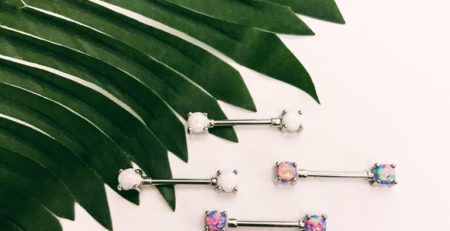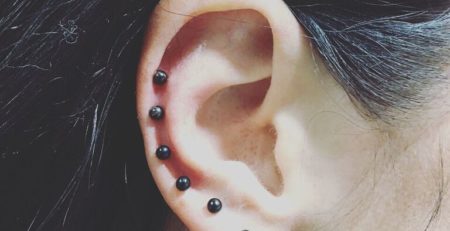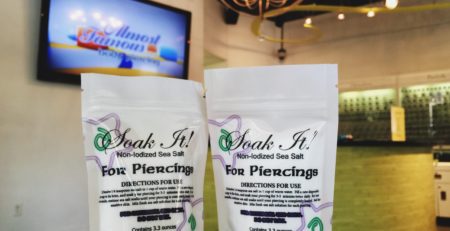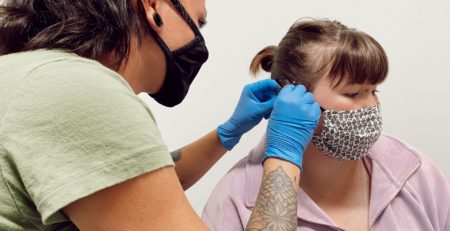Common Piercing Problems
If you’re having issues with your piercing, know that you are not alone. Piercings can be finnicky! A piercing is a wound and your body treats it as such in order to heal it. At first, your body will see it is as a
foreign body, something that it needs to remove, kind of like a sliver, so it’s important to be vigilant
about doing aftercare multiple times a day. It’s also important to only ever touch your piercing with
clean hands. Sort of like touching something and inoculating yourself by touching your nose, mouth, or
eyes, the same can happen with a piercing and irritation or infection.
There are a range of other issues, though, that can arise with both healing and healed body piercings.
We hope this blog post offers some guidance in these areas and if you still have questions, let us know!
We’re here to help!
Piercing has a bump –
Does your piercing have a flesh colored bump? What about a thick, red bump?
This could either be a keloid scar or a healing bump. A keloid scar is just that, a scar, so unfortunately
there is very little one can do to get rid of it without going to see a doctor. If it’s a healing bump, these
are fairly common and are fairly easy to get rid of. It just requires a bit of patience and a whole lot of
aftercare. Healing bumps form when drainage, soaps or facial/body products, or residues from makeup
get trapped inside the piercing and build up. In order to get the gunk out, it’s imperative to soak the
piercing. This will allow the solution to flush out the piercing and remove everything from the inside,
hard to reach places. You’ll do this with non-iodized sea salt. Another great product for getting rid of a
healing bump is pure glycerin soap, which removes products and residues from the surface before they
can make their way into the piercing.
We actually curated a bundle of products for this “piercing problem” in particular. Our Healing Bump
Bundle contains sea salt, glycerin soap, and tea tree oil.
Piercing is red –
Is your piercing red? There are a few things to consider. If your piercing is fresh, this is totally normal.
Redness is a part of the inflammatory phase when the permeability of the vessels increases, permitting
fluid to accumulate in the issue around the wound and you may also experience swelling, soreness, and
drainage.
If your piercing is red in combination with oozing a bloody/greenish drainage, hot to the touch, or a
fever with no other flu-like symptoms, that’s when a trip to the doctor may want to be in order because
this could be an infection and may require antibiotics.
Piercing is weeping a clear-ish drainage –
If your piercing is weeping a thin/clear drainage and it is red, this could be a sign of a metal allergy. It’s
always important to get pierced with quality jewelry to limit the chances of this. However, sometimes
people have allergies that they’re unaware of. If you were pierced with surgical steel but have a nickel
allergy for instance, you may need titanium jewelry. Be sure to stop in and see if a piercer if you’re
experiencing weeping in your piercing and they can help you out with further instructions!
Piercing is red, sore, and oozing a bloody/greenish drainage –
If your piercing is oozing a drainage that is green and/or bloody, it hurts worse than when you got it
pierced, it’s hot to the touch, or you have a random fever with no other flu-like symptoms, these could
be signs of infection. Since we are not medical professionals, we can not say that it is or isn’t but if
you’re experiencing one or more of these, we always recommend a trip to the doctor. A lot of times,
infection is simply from touching your piercing without first washing your hands.
Piercing looks like it is pushing out/getting thinner –
Piercing rejection is a real thing and it’s something that is even more common in surface piercings.
Piercings such as the navel, eyebrow, dermals, or surface bars are subject to rejection. This is where
your body begins pushing the piercing out. A navel piercing that once had a lot of skin holding it in may
continue pushing out until you can almost see the bar through it. If you think your piercing is possibly
rejecting, see a piercer so they can take a look in person and give you the best course of action. Typically
we will recommend removing the jewelry until it fully heals and then repiercing it again, if that is
something that you want to do. Sometimes the scar tissue from the previous piercings helps it stay the
next time around. One way to help avoid rejection is to be very careful with your piercing, especially
when your piercing is fairly fresh and still healing. Another way is to be vigilant in doing aftercare on
your piercing so that the body is able to accept it rather than trying to push it outwards like a sliver.
As you can see, amongst the many many pros to getting a piercing, there are also some cons. These can
happen to anyone but the more you care for your piercing and the better you treat it, the likelier you
are to have a happy, healed piercing. If you still have questions, please feel free to give us a call at any of
our 8 store locations, email us at [email protected], or message us on any social media
platforms!














Leave a Reply